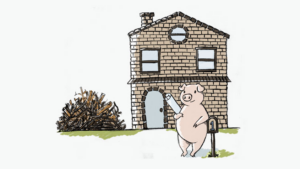
New model for financing affordable housing
A housing finance ‘aggregator’ is one solution for attracting more private capital into the affordable housing market. This article explains how it would work and how it fits with other policy options available to Federal and state governments.

- There is a massive shortfall in affordable housing — for people on low incomes.
- A model for a housing finance aggregator would provide access to lower cost debt and for longer terms to community housing providers unlocking desperately needed fit-for-purpose funding into the sector.
- The Australian Housing Finance Aggregator is based on the UK’s Housing Finance Corporation which has successfully demonstrated the role of an aggregator in stimulating social and affordable housing finance.
Housing affordability is a term that evokes a whole host of emotions. Frustration. Anger. Disappointment. And for some, desperation. The annual Anglicare Rental Affordability Snapshot for 2016 surveyed 75,410 rental properties and found that just 21 were affordable for a single person on Newstart and just 121 for a single person on Newstart with one child.[1] To say that Australia has a huge shortfall in housing for people on low incomes is a gross understatement.
Whilst not the silver bullet to solving the affordable housing challenge, this model is a viable solution…
The challenges for a single parent on Newstart seem a long way from the investment decisions of institutional investors such as superannuation funds – a system that manages well over a trillion dollars of capital on behalf of ordinary Australians. And yet Social Ventures Australia (SVA) is convinced that superannuation funds can be, and should be, part of the solution to the affordable housing challenge in Australia.
In response to the Federal Government’s exploration of innovative models for delivering affordable housing, SVA and Macquarie have proposed a housing finance aggregator, that would enable social[2] and affordable[3] housing providers to access lower cost debt for longer terms unlocking desperately needed ‘fit-for-purpose’[4] funding into the sector.
Whilst not the silver bullet to solving the affordable housing challenge, this model is a viable solution that, with limited Government support, could greatly contribute to increasing the stock of social and affordable housing across the country.
The social and affordable housing challenge
The Australian Housing and Urban Research Institute (AHURI) calculated Australia’s shortfall in affordable and available private rentals for people with low income at almost 400,000 properties in 2011, up from 225,000 in 2006.[5] This means many of these people cannot afford to rent a place to live as starkly outlined earlier by the Anglicare Rental Affordability Snapshot; and for those who do, a majority experience insecurity due to rental stress.[6]
The solution requires the government, private sector, institutional investors and non-profit organisations to work together in new and collaborative ways.
The reasons for the shortfall are two-fold: first, there is not enough suitable – by design, location and type – and affordable housing stock and second, where there is available affordable accommodation for those with incomes in the bottom 40 per cent, the houses aren’t available due to higher income earners occupying the lower-cost end of the rental market.[7] Social housing waiting lists are also growing, and there are now in excess of 215,000 people eligible for social housing but unable to access a place to call home.[8]
State governments are currently experiencing unsustainable operating deficits on their aging public housing and are seeking innovative ways of providing financially sustainable social and affordable housing.
The solution requires the government, private sector, institutional investors and non-profit organisations to work together in new and collaborative ways.
Improving housing outcomes for low income earners requires a multifaceted approach. This includes:
- Improving the supply of housing stock across the housing continuum from crisis refuges to affordable housing for key service workers such as nurses and teachers (see Figure 1);
- Transforming state government housing portfolios to become financially sustainable through effective partnerships with the community housing sector;
- Integrated and targeted support services for people who need them; and
- Opportunities for people to move along the housing continuum where appropriate.

Critical to achieving these objectives is connecting fit-for-purpose capital to the social and affordable housing sector.
Connecting institutional investors to social and affordable housing
In Australia there is a mismatch between the supply of appropriate capital and the underlying demand for social and affordable housing. While restricted funding is not the only contributor to the chronic shortfall in social and affordable housing stock, improved access to capital is an important piece of the puzzle in addressing the challenge.
There is tremendous potential to use private sector financing including institutional capital to help bridge the gap in supply.
… there’s a key role for government to play to enable the flow of private capital, particularly institutional capital, into the sector.
Compared with overseas jurisdictions including the United Kingdom and United States, the scale and sophistication of social and affordable housing finance in Australia is limited.
Australia’s largest non-profit community housing providers (CHPs) each typically own or manage around 2,000-3,000 dwellings.
This fragmentation results in less economies of scale for providers and a perception of increased credit risk from institutional investors limiting the ability for CHPs to access low cost capital over longer terms.[9] Institutional investors are seeking large scale (greater than $100m) transactions lending (or investing) to organisations with a recognised credit rating.
By contrast, in the UK, non-profit housing associations have secured 62 billion pounds in loans from two million dwellings transferred from the public sector. The housing sector in Australia is not yet at this size or sophistication.
The other challenge in attracting private capital is that rental yields are significantly below market returns making it a less attractive investment.
For this reason, there’s a key role for government to play to enable the flow of private capital, particularly institutional capital, into the sector. There are a number of ways that government can help to stimulate private sector investment in social and affordable housing, as detailed in Table 1.
| Lever | Examples | Government Responsibility | Impact |
| Construction / development costs | Innovative design & building concepts | N/A | LOW |
| Financing costs | Interest rate subsidy | Cwth | MEDIUM |
| Financing terms | Longer financing terms of up to 15-20 years | Cwth / State | MEDIUM |
| Management rights transfer | Enable stock to be transferred so that rental income can be borrowed against | State | MEDIUM |
| Planning regulations | Include 10-15% affordable housing inclusion in zoning regulations | State | MEDIUM |
| Income support | Commonwealth Rental Assistance indexed to market rent | Cwth | MEDIUM/ HIGH |
| Tax incentive | Put appropriate rental assistance scheme in place, building on NRAS model | Cwth | HIGH |
| Land costs | Land gifted or leased at peppercorn rent from the State | State | HIGH |
| Land / stock ownership transfer | Title transfer of social housing to CHPs with leverage commitments | State | HIGH |
Over the past 20 years, a number of these levers have been pulled by respective governments with varied levels of success. One of the big frustrations of both the social and affordable housing sector along with institutional investors is the frequency in which public policy has changed and therefore created uncertainty for all stakeholders.
Putting aside the merits of the policy initiative, the National Rental Affordability Scheme is a recent example of this. Institutional investors are attracted to markets and assets with stable regulatory environments and reliable cash flows. Short term measures and inconsistent policy direction creates uncertainty that makes investors nervous and unlikely to invest in such a market.
The model would allow housing providers to access funding at lower interest rates and for longer terms …
Unlocking institutional capital at scale
Informed by the experience internationally, notably in the UK, the model proposed by SVA and Macquarie Group addresses two of the levers in Table 1 (financing costs and financing terms) that could contribute to a better flow of capital into the sector. While not a silver bullet, a housing finance aggregator has been successfully implemented in the UK and has proven to be an effective and practical financing solution. We believe it would be the most efficient way to make a significant contribution to the pipeline of social and affordable housing.
From our research and knowledge of institutional investors, it is clear that there is strong interest in the private sector to invest in social and affordable housing if the right conditions and regulatory environment is in place.
The model we have developed is based on an Australian housing finance aggregator which essentially aggregates housing providers’ finance needs. The model would allow housing providers to access funding at lower interest rates and for longer terms and as a result unlock fit-for-purpose capital into the sector.
The best outcomes will be achieved through mutually enforcing initiatives at both the state and Commonwealth levels.
Importantly, we have ensured this solution is affordable for the Federal Government and encourages them to act as an enabler to improve housing outcomes rather than just as a funder, landlord or developer.
The proposed model operates within the larger housing ecosystem, so government has the potential through policy changes within that broader system to support the model’s operation. The best outcomes will be achieved through mutually enforcing initiatives at both the state and Commonwealth levels.
For example, the value of a finance housing aggregator is increased if there are planning policies that encourage large scale mixed tenure redevelopments as in NSW (Communities Plus) and support for rental income (Social and Affordable Housing Fund).
Explaining the Australian Housing Finance Aggregator
The Australian Housing Finance Aggregator (AHFA) would be a similar entity to the Housing Finance Corporation in the UK which has demonstrated the successful role of an aggregator in stimulating social and affordable housing finance.
The Housing Finance Corporation is the foremost aggregating funder to UK housing associations. It has held an A+ credit rating since 2003[10] and as at 31 March 2015, had outstanding loans exceeding £4.15 billion in value.[11]
A not for profit entity, the AHFA would liaise with social and affordable housing providers (including CHPs, and others[12] to determine the amount of debt they seek to raise. It would aggregate these funding needs and source from superannuation funds and other institutional investors. The funds would be loaned to the relevant social and affordable housing providers in return for ongoing interest payments and the return of capital at the end of the loan life.

The Australian Housing Finance Aggregator would have both sector and financial expertise and resources.
The Australian Housing Finance Aggregator would:
- carry out credit assessments on appropriate housing providers;
- issue debt instruments of different maturities to institutional investors;
- liaise with regulatory bodies to ensure improved governance and regulation of the social and affordable housing sector; and
- ensure compliance to guarantee housing providers are able to meet their debt obligations.
The establishment of the Australian Housing Finance Aggregator would generate a myriad of benefits for all key stakeholders to ultimately generate improved outcomes for those most in need. These benefits include:
- Housing providers would have access to capital which is more fit-for-purpose, that is over longer tenor (of 15-25 years) and on lower cost terms.
- Institutional investors will have a financing vehicle to achieve long term secure and stable returns as part of their portfolio whilst also supporting the social and affordable housing sector. The AHFA would have investment characteristics such as a Government-backed credit rating with appropriate risk adjusted returns that are similar to other asset classes that institutional investors are familiar with.
- The Commonwealth Government would likely play a short term support role to help establish the AHFA. This would require some form of credit enhancement, potentially a full or partial guarantee, for a finite period as the AHFA scales up and builds a portfolio of stable, predictable and risk-weighted investments. The administrative cost of the Government increasing regulatory oversight could be minimised by providing the AHFA with powers of intervention over poorly-performing borrowers. This would provide de facto regulation of CHPs who use the aggregator until funding to the sector increases in scale and sophistication and an independent regulator could be established.
- There are a number of state government initiatives currently underway that would compliment the AHFA’s function. These include but are not limited to the Social and Affordable Housing Fund (NSW), the Communities Plus Program (NSW), the Connected Living Initiative (WA) and the Renewal SA transfer program (SA).
Conclusion
The investment decisions of Australia’s multi-trillion dollar superannuation industry could impact the life of a single parent on Newstart seeking a suitable and affordable home in Sydney or Melbourne or Perth. Even a small slice of this institutional capital (managed on behalf of ordinary Australians) invested into the social and affordable housing sector could make a significant contribution to the 400,000 properties needed to support those on low incomes.
…this model is a proven and practical solution that could greatly contribute to increasing the pipeline of social and affordable housing.
As acknowledged earlier, the Australian Housing Finance Aggregator model is only one piece of the puzzle of the larger housing system required to address the chronic shortfall in social and affordable housing.
However, we believe this model is a proven and practical solution that could greatly contribute to increasing the pipeline of social and affordable housing.
State and Federal governments have expressed a desire to increase the supply of affordable housing as a means of achieving better and more sustainable economic and social outcomes. Given the budgetary constraints that governments face, the private and non-profit sectors have an opportunity to collaborate in this solution.
SVA and Macquarie Group have made a submission proposing this model to the Council on Federal Financial Relations Affordable Housing Working Group: Innovative financing models.
Author: Mark Peacock
[1] Anglicare Australia’s 2016 Rental Affordability Snapshot
[2] Social housing is a type of affordable housing and covers public housing (owned and managed by the Government) and community housing (owned and/or managed by community housing providers (CHPs). NSW Family & Community Services, Social Housing in NSW, A discussion paper for input and comment, 2014
[3] Affordable housing is here defined as housing available at below-market rate.
[4] Fit-for-purpose is a reference to the tenor and terms of financing to match the life and tenor of the underlying asset e.g. social and affordable housing with a 40-50 year useful life requires funding to match this term where possible.
[5] Hulse, K., Reynolds, M. and Yates, J. (2014) Changes in the supply of affordable housing in the private rental sector for lower income households, 2006–11, AHURI Final Report No. 235, Australian Housing and Urban Research Institute Limited, Melbourne, pg 2.
[6] Australian Institute of Health and Welfare 2014. Housing assistance in Australia 2014. Cat. No. HOU 275. Canberra: AIHW, pg 67.
[7] NHSC (National Housing Supply Council) 2012, Housing Supply and Affordability – Key Indicators 2012, Commonwealth of Australia, Canberra, pp47-9; Australian Institute of Health and Welfare 2014. Housing assistance in Australia 2014. Cat. No. HOU 275. Canberra: AIHW, pg 23; Hulse, K., Reynolds, M. and Yates, J. (2014) Changes in the supply of affordable housing in the private rental sector for lower income households, 2006–11, AHURI Final Report No. 235, Australian Housing and Urban Research Institute Limited, Melbourne.
[8] Waiting list of 197,500, current supply of social dwellings 403,767. Source: Productivity Commission 2016, Report on Government Services 2016 Chapter 17.
[9] For example, see 2015 Annual Reports for: BlueCHP; Bridge Housing; Mission Australia Housing; and St George Community Housing
[10] The Housing Finance Corporation Annual Report 2015, The Housing Finance Corporation website, 2015
[11] Ibid.
[12] Such as real estate investment trusts (REITs) and special purpose vehicles (SPVs).







